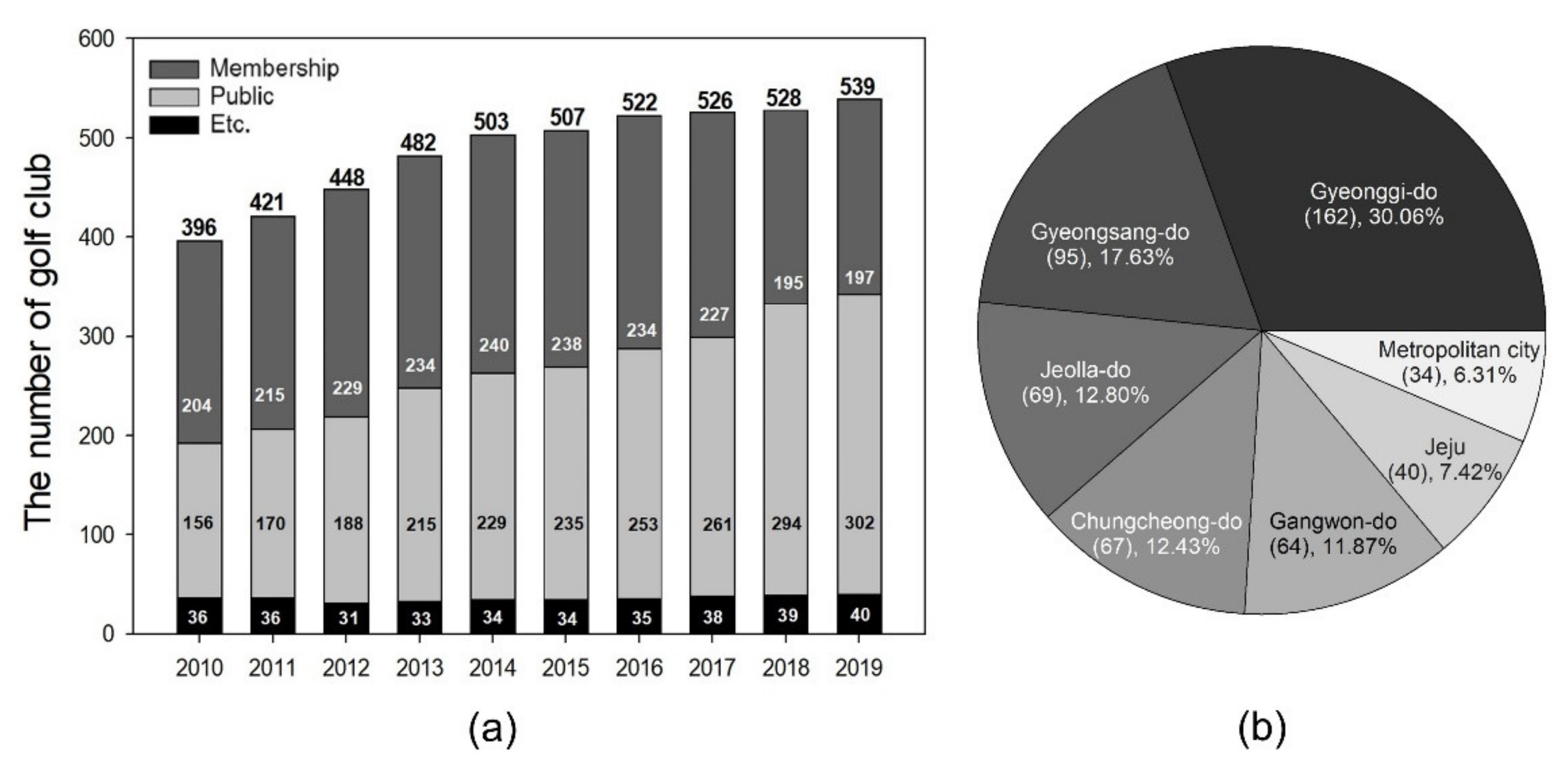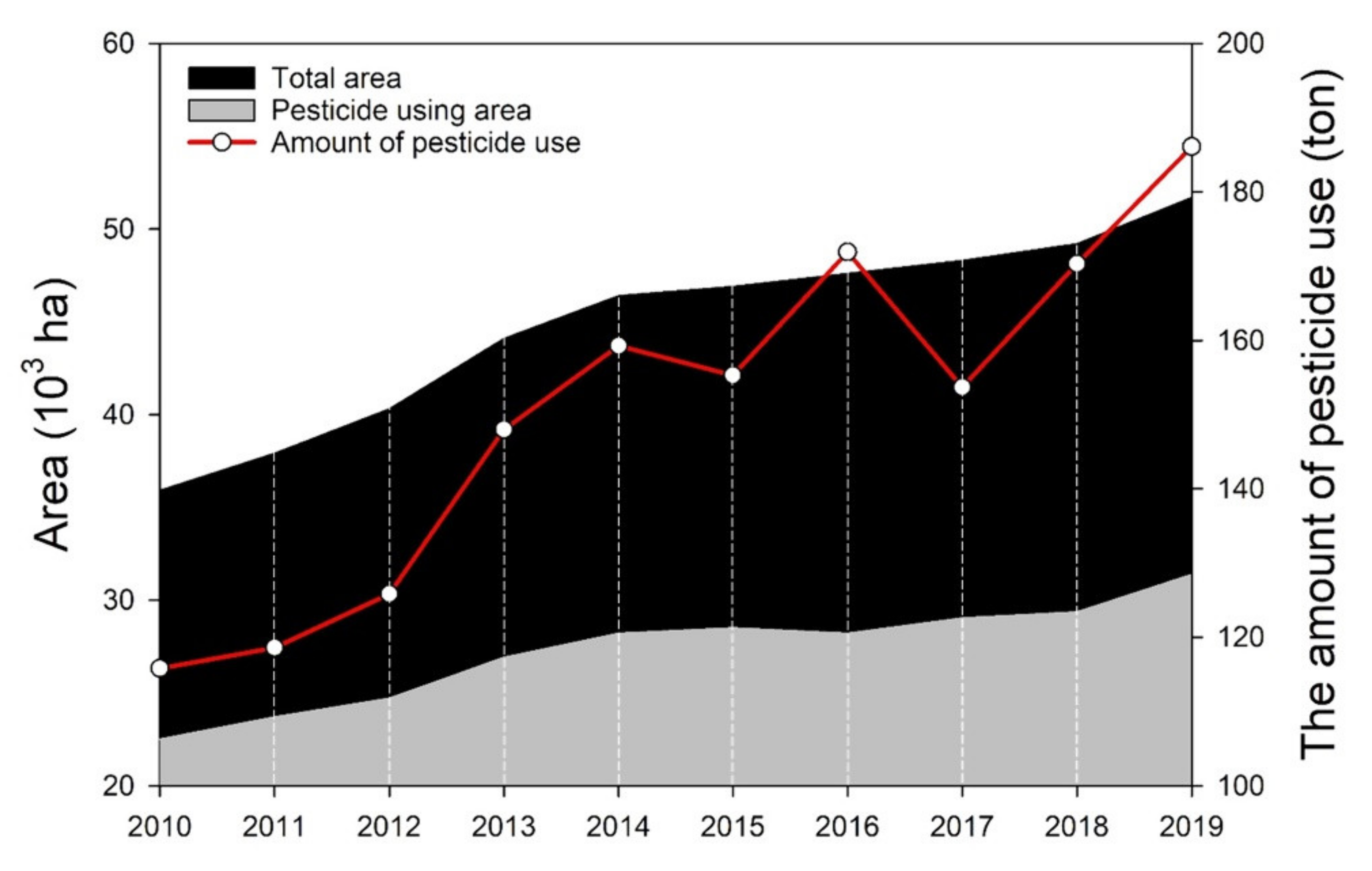Status of Pesticide Usage on Golf Courses in Korea and Optimal Pesticide Usage Plan
Abstract
:1. Introduction
2. Materials and Methods
2.1. Information Regarding Pesticides on Golf Courses
2.2. Distribution Map of the Quantity of Pesticide Usage Per Unit Area of Korean Golf Courses
2.3. Best Management Practices on Golf Courses in Foreign Countries
3. Results and Discussion
3.1. Status of Korean Golf Courses
3.2. Status of Pesticide Usage on Golf Courses
3.3. Quantity of Pesticides Used Per Unit Area on Golf Courses
3.4. Optimal Management Plan for Pesticide Usage on Golf Courses
4. Conclusions
Author Contributions
Funding
Institutional Review Board Statement
Informed Consent Statement
Data Availability Statement
Conflicts of Interest
References
- Kim, Y.S.; Lee, K.S.; Lee, G.J. Strategies of eco-friendly turfgrass management and resource recycling for a sustainable golf course. Weed Turfgrass Sci. 2019, 8, 83–98. (In Korean) [Google Scholar] [CrossRef]
- Lee, J.B.; You, A.S.; Oh, J.A.; Park, S.; Jo, Y.; Lee, N.; Park, Y.K. Risk assessment of pesticide applicators and passengers of fungicides registered for use on the lawn. Korean J. Pestic. Sci. 2018, 22, 122–130. (In Korean) [Google Scholar] [CrossRef]
- Yoo, M.J.; Lee, J.P.; Joo, Y.K.; Kim, D.H. Analysis of maintenance expense in various golf courses. Korean Turfgrass Sci. 2009, 23, 61–76. [Google Scholar]
- Christian, N. Environmentally sound turfgrass management. Korean Turfgrass Sci. 2005, 19, 177–183. [Google Scholar]
- Pesticide Control Act in Korea. Available online: https://www.law.go.kr/LSW/eng/engLsSc.do?menuId=2§ion=lawNm&query=pesticide+control+act&x=47&y=34#liBgcolor6 (accessed on 10 March 2022).
- Korea Rural Development Administration, Pesticide Safety Information System. Available online: https://psis.rda.go.kr/psis (accessed on 6 October 2021).
- Kwon, G.H. Status of Usage and Problems of Pesticides Used in Trees. In Proceedings of the 2021 Spring Conference of the Korean Society of Pesticide Science, Cheonan, Korea, 14 May 2021; pp. 37–43. [Google Scholar]
- Water Environment Conservation Act in Korea. Available online: https://www.law.go.kr/LSW/eng/engLsSc.do?menuId=2§ion=lawNm&query=pesticide+control+act&x=47&y=34#liBgcolor3 (accessed on 10 March 2022).
- Regulations on Surveying the Amount of Pesticide Use in Golf Courses and Test Methods. Available online: https://www.law.go.kr/admRulSc.do?menuId=5&subMenuId=41&tabMenuId=183&eventGubun=060115#liBgcolor0 (accessed on 10 March 2022).
- Fisher, I.J.; Philips, P.J.; Bayraktar, B.N.; Chen, S.; McCarthy, B.A.; Sandstrom, M.W. Pesticides and their degradates in groundwater reflect past use and current management strategies, Long Island, New York, USA. Sci. Total Environ. 2021, 752, 141895. [Google Scholar] [CrossRef] [PubMed]
- Derbalah, A.; Tahara, K.; Sakugawa, H. Monitoring sources, discharge, and fluxes of, and assessing the risks from, pesticides in the Kurose and Ashida Rivers, Japan. Int. J. Environ. Sci. Technol. 2019, 17, 1035–1050. [Google Scholar] [CrossRef]
- Minoli, D.M.; Goode, M.M.H.; Smith, M.T. Are eco labels profitably employed in sustainable tourism? A case study on Audubon certified golf resorts. Tour. Manag. Perspect. 2015, 16, 207–216. [Google Scholar] [CrossRef]
- Ministry of Environment. Planning and Research Report for Establishment of Eco-Friendly Golf Courses and Evaluation Standard; Ministry of Environment: Sejong-si, Korea, 2012.
- Baek, J. The Voluntary Sustainability Standard for Golf Course Development and Management. Ph.D. Dissertation, Seoul National University, Seoul, Korea, July 2015. (In Korean). [Google Scholar]
- Chang, C.H.; Lee, C.W. Phenomenological analysis on the leisure sport experience in the COVID-19 situation. Korean J. Sports Sci. 2021, 30, 43–56. (In Korean) [Google Scholar] [CrossRef]
- Lee, J.H.; Bae, I.S.; Ha, K.T.; You, S.S.; Han, K.M.; Eo, S.M.; Jung, K.; Lee, J.S.; Koo, J.Y. A study on the distribution map construction of asbestos building owned by Seoul using QGIS. J. Korean Soc. Environ. Eng. 2016, 38, 528–533. (In Korean) [Google Scholar] [CrossRef]
- Chung, J.S.; Yoon, S.M. Analysis on effect of convering member – only golf courses to public golf courses – Focusing on the tax effects and non-tax effects of AG golf course. Korean J. Tax Res. 2017, 34, 177–205. (In Korean) [Google Scholar]
- Ryu, J.; Park, H. Proposal for improving local tax on original form preservation area in golf courses: Focusing on property tax. Local Tax Rev. 2021, 8, 115–140. (In Korean) [Google Scholar] [CrossRef]
- Roh, D.Y.; Han, K.S. The effect of selection attributes on service quality and purchase behaviors on golf course. J. Sport Leisure Stud. 2011, 44, 161–172. (In Korean) [Google Scholar] [CrossRef]
- Yoo, K.H.; Park, D.Y. An analysis of demand prediction with the use of seasonal ARIMA model for golfers participating in sport for all in Gyeonggi-do area. Korean J. Sports Sci. 2012, 21, 561–573. (In Korean) [Google Scholar] [CrossRef]
- Kang, J.H.; Kim, H.S.; Kwon, K.S.; Lee, J.M.; Lee, S.H. Korea Golf Industry White Paper; Yuwon Golf Foundation, LJ Books: Seoul, Korea, 2020. [Google Scholar]
- Kim, D.J.; Yoon, J.K.; Yoo, J.; Kim, S.J.; Yang, J.E. Status and management strategy of pesticide use in golf courses in Korea. J. Appl. Biol. Chem. 2014, 57, 267–277. (In Korean) [Google Scholar] [CrossRef]
- Lee, B.; Jang, M. Spatial characteristics analysis by detecting person-environment interactions associated with boundaries. J. Korean Assoc. Region Geogr. 2019, 25, 230–248. (In Korean) [Google Scholar] [CrossRef]
- Choi, J.Y.; Yang, D.B.; Lee, S.G.; Bang, J.H.; Hong, G.H.; Shin, K.H. Organophosphorus pesticide distribution in seawater from Asan bay, Korea in 2008. Ocean Polar Res. 2010, 32, 203–212. (In Korean) [Google Scholar] [CrossRef]
- Gyeonggi-do (GG). Gyeonggido New Portal. 2015. Available online: https://gnews.gg.go.kr (accessed on 22 December 2021).
- Korea Turfgrass Research Institute, Golf Course Management Calendar. Available online: http://www.ktri.or.kr/news/calendar/2021/Calendar_2021.pdf (accessed on 29 April 2022).
- Kim, K.U.; Choi, S.T.; Kim, H.Y.; An, Y.T.; Kim, I.S. Weed flora of golf fields in Korea. Korean K Turfgrass Sci. 1990, 4, 31–41. (In Korean) [Google Scholar]
- Choo, H.Y.; Lee, D.W.; Park, J.W.; Lee, J.W. Comparison of four major scarab beetles, extinohoplia rufipes, adoretus tenumiaculatus, exomala orientalis and popillia quadriguttata in golf courses. Korean Turfgrass Sci. 1999, 13, 101–112. (In Korean) [Google Scholar]
- Shim, G.Y.; Lee, J.H. Research review on turfgrass disease in Korea. Weed Turfgrass Sci. 2018, 7, 87–97. (In Korean) [Google Scholar] [CrossRef]
- Moon, K.H.; Seo, H.H.; Sonn, Y.K.; Song, K.C.; Hyun, H.N. Quantitative approach of soil prediction using environment factors in Jeju Island. Korean J. Soil Sci. Fert. 2012, 45, 360–369. (In Korean) [Google Scholar] [CrossRef] [Green Version]
- Kim, K.D.; Lee, S.H. The characteristics of folk house related to climate in Cheju Island. J. Korean Assoc. Region Geograph 2001, 7, 29–43. (In Korean) [Google Scholar]
- Lee, J.J.; Jeon, G.Y. Architectural and exterior material features according to the climatic difference in Jeju Houses. J. Korean Soc. Living Environ. Syst. 2014, 21, 42–50. (In Korean) [Google Scholar] [CrossRef]
- Burri, N.M.; Weatherl, R.; Moeck, C.; Schirmer, M. A review of threats to groundwater quality in the anthropocene. Sci. Total Environ. 2019, 684, 136–154. [Google Scholar] [CrossRef]
- Statistics Korea (KOSTAT). Government Administration Monitoring System. 2021. Available online: https://www.index.go.kr (accessed on 12 November 2021).
- Larsen, A.E.; Noack, F. Identifying the landscape drivers of agricultural insecticide use leveraging evidence from 100,000 fields. Proc. Natl. Acad. Sci. USA 2017, 114, 5473–5478. [Google Scholar] [CrossRef] [PubMed] [Green Version]
- Song, Y.O. Survey on Golf Courses and Turfgrass Management in Jeju. Master’s Dissertation, Jeju National University, Jeju, Korea, 2011. (In Korean). [Google Scholar]
- Hoy, C.W. Pesticide Resistance Management. In Integrated Pest Management: Concepts, Tactics, Strategies and Case Studies; Radcliffe, E.B., Hutchinson, W.D., Cancelado, R.E., Eds.; Cambridge University Press: Cambridge, UK, 2009; pp. 192–204. [Google Scholar]
- Jeon, J.; Lee, C. Critical review on the cluster adaptive cycle model. J. Econ. Geogr. Soc. Korean 2017, 20, 189–213. (In Korean) [Google Scholar] [CrossRef]
- Martin, R.; Sunley, P. Conceptualizing cluster evolution: Beyond the life cycle model? Region Stud. 2011, 45, 1299–1318. [Google Scholar] [CrossRef]
- Yasuda, M.; Koike, F. Do golf courses provide a refuge for flora and fauna in Japanese urban landscapes? Land Urban Plan. 2006, 75, 58–68. [Google Scholar] [CrossRef]
- Yasuda, M.; Koike, F.; Terman, M. How management practices affect arthropod communities on Japanese golf courses? Landscape Ecol. Eng. 2008, 4, 133–138. [Google Scholar] [CrossRef]
- Kato, M. Integral Turf Management for Reducing Pesticide Usage in Japanese Golf Courses. Korean Turfgrass Sci. 2005, 19, 161–175. [Google Scholar]
- New South Wales Environment Protection Authority. Improving the Environmental Management of New South Wales Golf Courses. Available online: https://www.environment.nsw.gov.au/resources/business/07588GolfCourses.pdf (accessed on 22 December 2021).
- Florida Department of Environmental Protection (FDEP). Best Management Practices for the Enhancement of Environmental Quality on Florida Golf Gourses; FDEP: Tallahassee, FL, USA, 2007.
- California Golf Course Superintendents Association of America (CGCSAA). California Golf Industry Best Management Practices Guide; CGCSAA: Sacramento, CA, USA, 2020.
- Lone Star Golf Course Superintendents Association of America (LSGCSAA). Loan Star Golf Industry Best Golf Management Practices Guide; LSGCSAA: Cypress, TX, USA, 2021.
- Zhang, W.; Swinton, S.M. Incorporation natural enemies in an economic threshold for dynamically optimal pest management. Ecol. Model. 2009, 220, 1315–1324. [Google Scholar] [CrossRef]
- Stenberg, J.A. A conceptual framework for integrated pest management. Trend Plant Sci. 2017, 22, 759–769. [Google Scholar] [CrossRef] [PubMed]
- Isard, S.A.; Mortensen, D.A.; Fleischer, S.J.; De Wolf, E.D. Application of Aerobiology to IPM. In Integrated Pest Management: Concepts, Tactics, Strategies and Case Studies; Radcliffe, E.B., Hutchinson, W.D., Cancelado, R.E., Eds.; Cambridge University Press: Cambridge, UK, 2009; pp. 90–106. [Google Scholar]
- Royal and Ancient Golf Club of St. Andrews (R&A). Golf Around the World 2021, 4th ed.; R&A: St. Andrews, UK, 2021. [Google Scholar]
- Kang, J.H.; Jeong, Y.J.; Lee, J.S. The impact of sport consumers’ need for uniqueness and vicarious nostalgia on the perceived value, satisfaction, and re-purchase intentions: Focusing on MZ generation’s New-tro sport product consumption. Korean J. Sport Manag. 2021, 26, 21–48. (In Korean) [Google Scholar] [CrossRef]








Publisher’s Note: MDPI stays neutral with regard to jurisdictional claims in published maps and institutional affiliations. |
© 2022 by the authors. Licensee MDPI, Basel, Switzerland. This article is an open access article distributed under the terms and conditions of the Creative Commons Attribution (CC BY) license (https://creativecommons.org/licenses/by/4.0/).
Share and Cite
Lee, H.-g.; Kim, M.-S.; Kim, J.y.; Kim, H.-K.; Jo, H.-W.; Moon, J.-K.; Kim, J.-I. Status of Pesticide Usage on Golf Courses in Korea and Optimal Pesticide Usage Plan. Sustainability 2022, 14, 5489. https://doi.org/10.3390/su14095489
Lee H-g, Kim M-S, Kim Jy, Kim H-K, Jo H-W, Moon J-K, Kim J-I. Status of Pesticide Usage on Golf Courses in Korea and Optimal Pesticide Usage Plan. Sustainability. 2022; 14(9):5489. https://doi.org/10.3390/su14095489
Chicago/Turabian StyleLee, Hong-gil, Min-Suk Kim, Jee young Kim, Hyun-Koo Kim, Hyeong-Wook Jo, Joon-Kwan Moon, and Ji-In Kim. 2022. "Status of Pesticide Usage on Golf Courses in Korea and Optimal Pesticide Usage Plan" Sustainability 14, no. 9: 5489. https://doi.org/10.3390/su14095489
APA StyleLee, H.-g., Kim, M.-S., Kim, J. y., Kim, H.-K., Jo, H.-W., Moon, J.-K., & Kim, J.-I. (2022). Status of Pesticide Usage on Golf Courses in Korea and Optimal Pesticide Usage Plan. Sustainability, 14(9), 5489. https://doi.org/10.3390/su14095489





